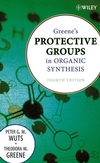abebas123
New Member

The Fourth Edition of Greene's Protective Groups in Organic Synthesis continues to be an indispensable reference for controlling the reactivity of the most common functional groups during a synthetic sequence. This new edition incorporates the significant developments in the field since publication of the third edition in 1998, including...
- New protective groups such as the fluorous family and the uniquely removable 2-methoxybenzenesulfonyl group for the protection of amines
- New techniques for the formation and cleavage of existing protective groups, with examples to illustrate each new technique
- Expanded coverage of the unexpected side reactions that occur with protective groups
- New chart covering the selective deprotection of silyl ethers
- 3,100 new references from the professional literature
CONTENTS
Preface to the Fourth Edition.
Preface to the Third Edition.
Preface to the Second Edition.
Preface to the First Edition.
Abbreviations.
1. The Role of Protective Groups in Organic Synthesis.
Preface to the Fourth Edition.
Preface to the Third Edition.
Preface to the Second Edition.
Preface to the First Edition.
Abbreviations.
1. The Role of Protective Groups in Organic Synthesis.
2. Protection for the Hydroxyl Group, Including 1,2- and 1,3-Diols.
Ethers.
Protection for 1,2- and 1,3-Diols.
3. Protection for Phenols and Catechols.
Ethers.
Protection for 1,2- and 1,3-Diols.
3. Protection for Phenols and Catechols.
Protection for Phenols.
Ethers.
Silyl Ethers.
Esters.
Carbonates.
Aryl Carbamates.
Phosphinates.
Sulfonates.
Protection for Catechols.
Cyclic Acetals and Ketals.
Cyclic Esters.
Protection for 2-Hydroxybenzenethiols.
Ethers.
Silyl Ethers.
Esters.
Carbonates.
Aryl Carbamates.
Phosphinates.
Sulfonates.
Protection for Catechols.
Cyclic Acetals and Ketals.
Cyclic Esters.
Protection for 2-Hydroxybenzenethiols.
4. Protection for the Carbonyl Group.
Acetals and Ketals.
Miscellaneous Derivatives.
Monoprotection of Dicarbonyl Compounds.
5. Protection for the Carboxyl Group.
Esters.
Amides and Hydrazides.
Protection of Boronic Acids.
Protection of Sulfonic Acids.
6. Protection for the Thiol Group.
Thioethers.
Thioesters.
Miscellaneous Derivatives.
7. Protection for the Amino Group.
Carbamates.
Amides.
Special —NH Protective Groups.
Protection for Imidazoles, Pyrroles, Indoles, and other Aromatic Heterocycles.
Protection for the Amide —NH.
Protection for the Sulfonamide —NH.
8. Protection for the Alkyne —CH.
9. Protection for the Phosphate Group.
Some General Methods for Phosphate Ester Formation.
Removal of Protective Groups from Phosphorus.
Alkyl Phosphates.
Phosphates Cleaved by Cyclodeesterifi cation.
Benzyl Phosphates.
Phenyl Phosphates.
Photochemically Cleaved Phosphate Protective Groups.
Amidates.
Miscellaneous Derivatives.
10. Reactivities, Reagents, and Reactivity Charts.
Reactivities.
Reagents.
Index.
Acetals and Ketals.
Miscellaneous Derivatives.
Monoprotection of Dicarbonyl Compounds.
5. Protection for the Carboxyl Group.
Esters.
Amides and Hydrazides.
Protection of Boronic Acids.
Protection of Sulfonic Acids.
6. Protection for the Thiol Group.
Thioethers.
Thioesters.
Miscellaneous Derivatives.
7. Protection for the Amino Group.
Carbamates.
Amides.
Special —NH Protective Groups.
Protection for Imidazoles, Pyrroles, Indoles, and other Aromatic Heterocycles.
Protection for the Amide —NH.
Protection for the Sulfonamide —NH.
8. Protection for the Alkyne —CH.
9. Protection for the Phosphate Group.
Some General Methods for Phosphate Ester Formation.
Removal of Protective Groups from Phosphorus.
Alkyl Phosphates.
Phosphates Cleaved by Cyclodeesterifi cation.
Benzyl Phosphates.
Phenyl Phosphates.
Photochemically Cleaved Phosphate Protective Groups.
Amidates.
Miscellaneous Derivatives.
10. Reactivities, Reagents, and Reactivity Charts.
Reactivities.
Reagents.
Index.
